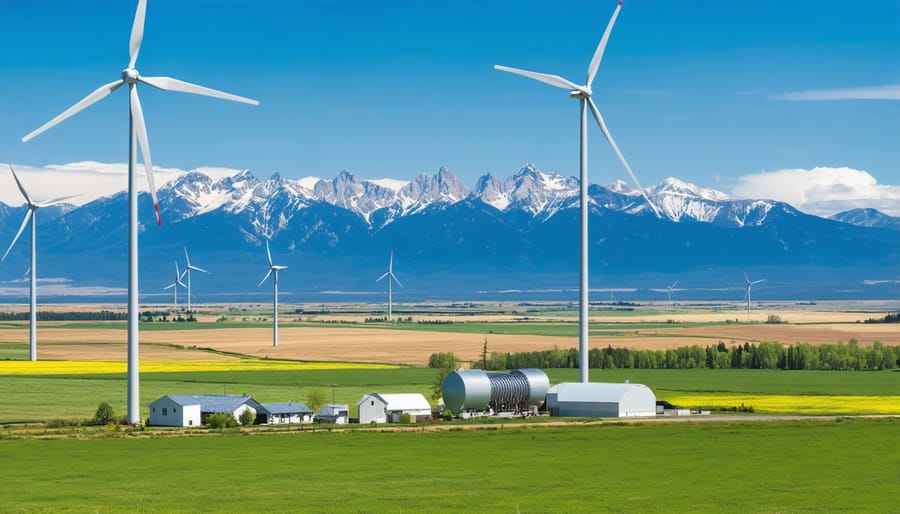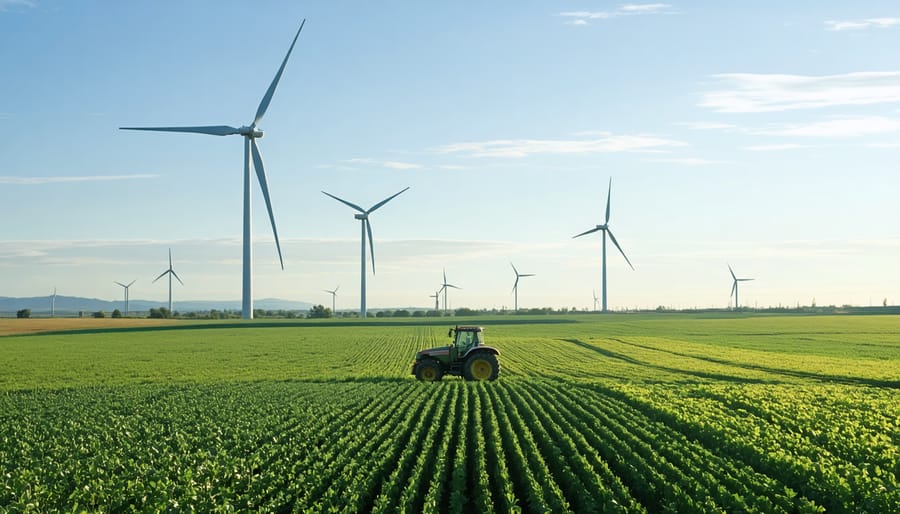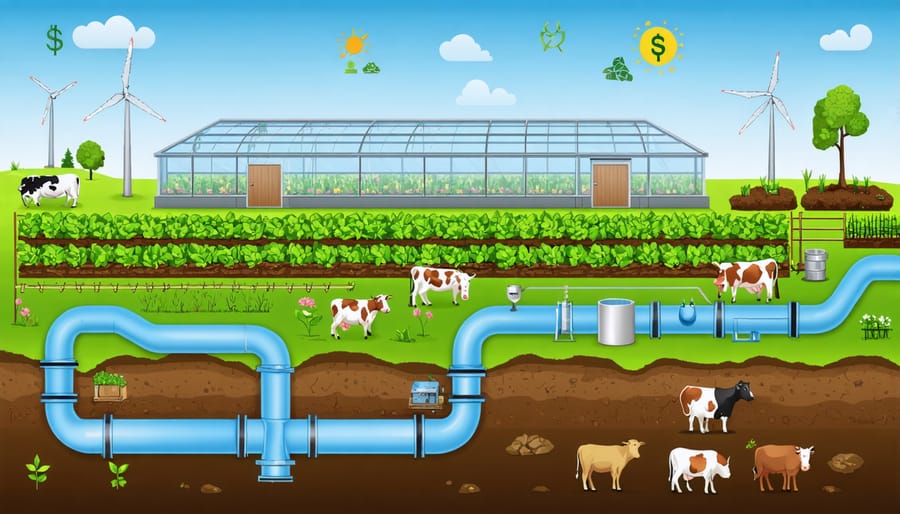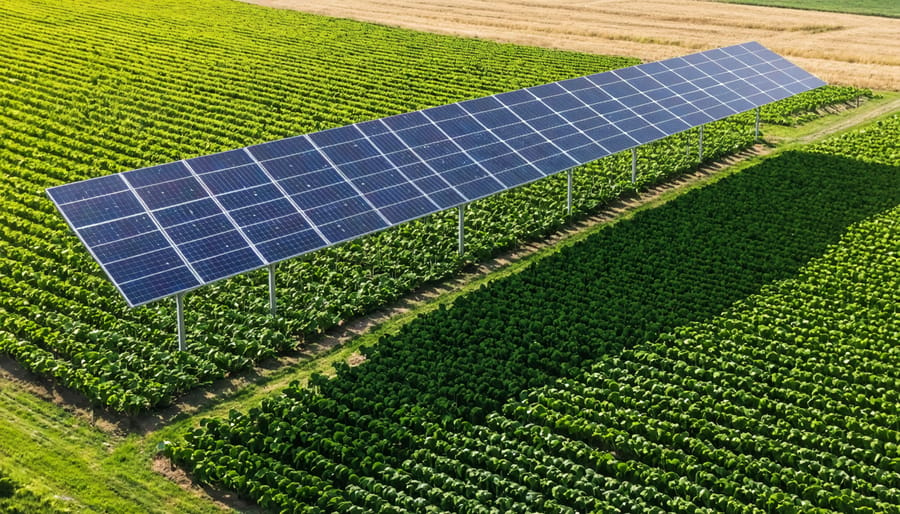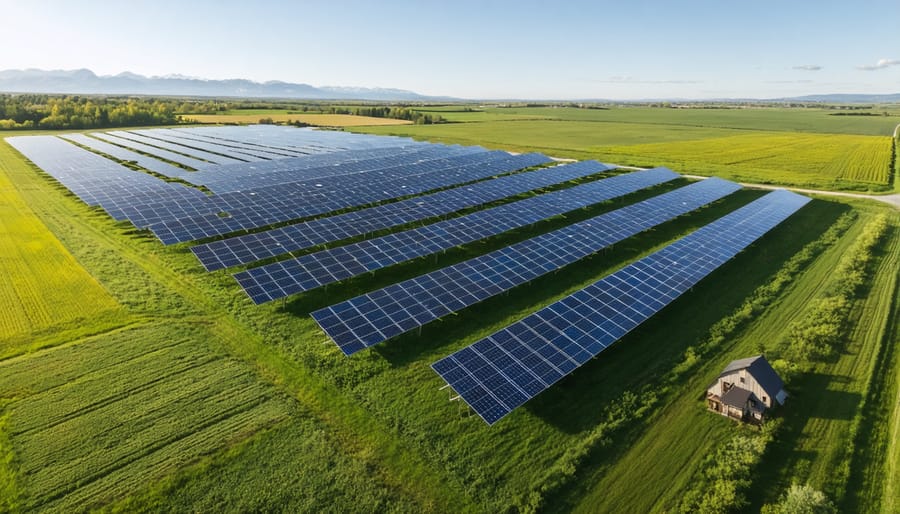Transform your farm’s wind energy potential into reliable power by integrating advanced storage systems with sustainable farm energy systems. Modern battery technologies now capture and store up to 80% of excess wind generation, providing consistent power even during calm periods. Alberta farmers already harness this technology, reducing energy costs by an average of 40% while maintaining critical operations during grid outages.
Wind energy storage solutions have evolved beyond traditional batteries, incorporating innovative flywheel systems and compressed air storage that thrive in Canadian prairie conditions. These hybrid systems, particularly effective in southern Alberta’s wind corridor, deliver reliable power through seasonal variations and extreme weather events. Local success stories, like the Morrison Farm in Foremost, demonstrate how integrated wind storage systems maintain consistent power for irrigation systems and grain drying operations year-round.
Partner with local agricultural cooperatives to access group purchasing power for storage equipment, cutting installation costs by up to 30%. Current federal and provincial incentives cover up to 50% of system costs, making 2024 an optimal time for Alberta farmers to invest in wind energy storage solutions.
Why Wind Energy Storage Matters for Alberta Farms
Alberta’s Wind Energy Potential
Alberta’s unique geographical position along the eastern slopes of the Rocky Mountains creates ideal conditions for wind energy generation. The region experiences consistent wind patterns, particularly in southern Alberta where average wind speeds reach 16-20 kilometers per hour throughout the year. Farming communities in areas like Pincher Creek and Fort Macleod have already tapped into this potential, with some operations generating enough power to meet their entire farm’s energy needs.
The province’s wind energy capacity has grown significantly, with current installations capable of powering over 960,000 homes. For farmers, this represents a remarkable opportunity to diversify income while maintaining agricultural operations. The Medicine Hat region, for example, has seen several successful installations where wind turbines coexist with crop production, utilizing less than 2% of the total land area.
Recent studies from the University of Alberta indicate that combining wind energy with modern storage solutions could help farming operations reduce their energy costs by up to 40%. The most promising areas for development include the corridor between Lethbridge and Medicine Hat, where wind patterns remain stable throughout the growing season.
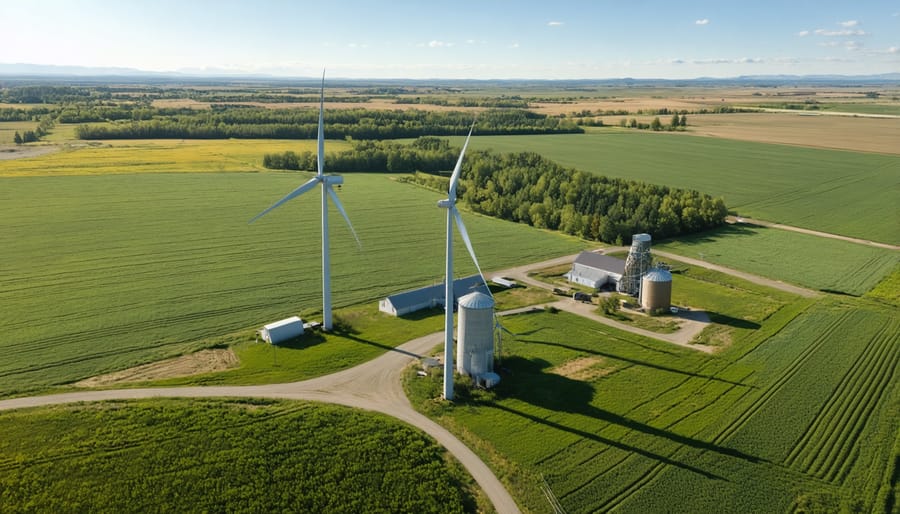
Cost Savings Through Strategic Storage
The implementation of wind energy storage systems has proven to be a game-changer for Canadian farmers focused on reducing farm energy costs. Take the example of the Wilson Family Farm in southern Alberta, which saw a 40% reduction in annual energy expenses after installing a 50 kWh battery storage system alongside their existing wind turbines. The storage solution allows them to use wind-generated power during peak rate hours, saving approximately $12,000 annually.
Similarly, the Cooperative Wind Energy Project in central Alberta, involving six neighbouring farms, demonstrated how shared storage infrastructure can maximize cost efficiency. By pooling resources to invest in a 200 kWh community storage system, each farm saved an average of $15,000 in the first year while maintaining stable power supply during critical operations.
The Mountain View Agricultural Society reports that farms using wind energy storage systems experience 30-45% lower electricity bills compared to those without storage capabilities. These savings typically offset the initial investment within 5-7 years, making it a practical long-term solution for sustainable farm operations.
Practical Storage Solutions for Your Farm
Battery Storage Systems
Battery storage systems are becoming increasingly popular among Alberta farmers as a reliable way to store excess wind energy for later use. These systems range from compact lithium-ion batteries suitable for small operations to larger-scale flow batteries that can power entire farm complexes.
For most agricultural operations, lithium-ion batteries offer the best balance of cost, efficiency, and lifespan. These systems can store enough energy to maintain critical farm operations during periods of low wind, typically providing 4-8 hours of backup power. Many Alberta farmers have found success pairing 50-100 kWh battery systems with their wind turbines, enough to power irrigation systems, barn ventilation, and essential equipment.
Local farmer Mike Thompson from Lethbridge County shares, “We installed a 75 kWh battery system last year. It’s been a game-changer during calm periods, keeping our dairy operation running smoothly without interruption.”
Newer technologies like flow batteries are gaining traction for their longer discharge times and durability in extreme temperatures, a crucial consideration for our prairie climate. While the upfront cost is higher, ranging from $15,000 to $40,000 for a complete system, many farmers report breaking even within 5-7 years through reduced energy costs and provincial renewable energy incentives.
When selecting a battery system, consider factors like daily energy consumption, peak load requirements, and available installation space. Local suppliers can help determine the right size and type for your specific needs.
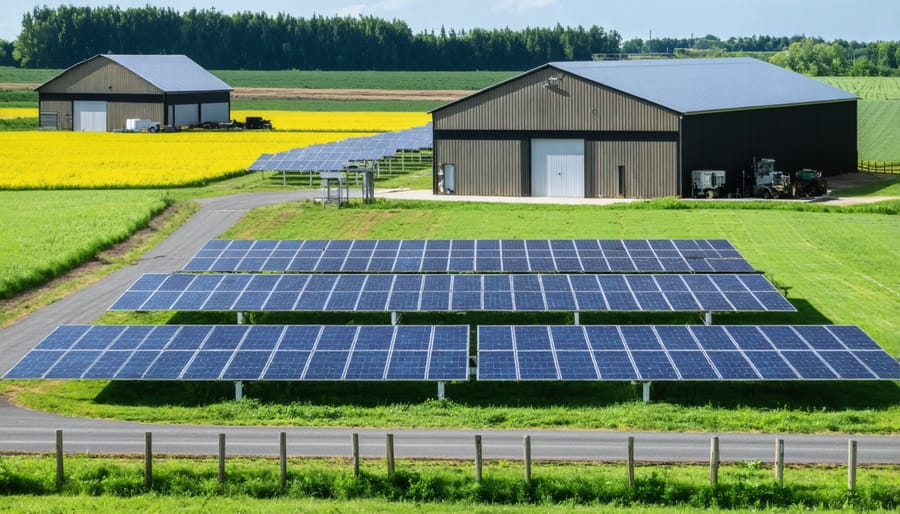
Mechanical Storage Solutions
When it comes to storing wind energy mechanically, two reliable solutions have proven particularly valuable for Alberta farms: flywheel systems and compressed air storage. These methods offer practical ways to capture excess wind power for later use, especially during peak farming operations.
Flywheel systems work like a high-tech version of a potter’s wheel, storing energy in a rotating mass. When excess wind power is available, it speeds up the flywheel, and when power is needed, the flywheel’s momentum is converted back to electricity. For example, the Thompson family farm near Red Deer uses a flywheel system to power their irrigation pumps during calm periods, saving them roughly 30% on energy costs.
Compressed air storage, on the other hand, uses surplus wind power to compress air into large tanks or underground caverns. When energy is needed, the compressed air is released through turbines to generate electricity. The Mackenzie Valley Farm Collective recently installed a compressed air system that provides backup power for their grain drying operations during harvest season.
Both systems have their place on Canadian farms. Flywheels are excellent for short-term storage and quick response times, while compressed air systems work well for longer-term storage needs. Many Alberta farmers find that combining these mechanical storage solutions with their existing wind turbines creates a more reliable and efficient power system throughout the year.
Consider your farm’s specific needs and energy patterns when choosing between these options. Local agricultural extension offices can help assess which system might work best for your operation.
Hybrid Storage Approaches
On many Alberta farms, combining wind energy storage with other storage methods has proven to be a game-changing approach. By integrating multiple systems, farmers can create more reliable and efficient energy solutions that work year-round. For example, the Morrison family farm near Lethbridge successfully pairs their wind storage system with solar power integration, ensuring consistent power supply even during periods of lower wind activity.
The key advantage of hybrid storage lies in its ability to balance different renewable energy sources throughout the year. During winter months when solar generation might be limited, wind energy often peaks, while summer brings increased solar potential. This complementary relationship helps maintain steady power availability for critical farm operations.
Many Alberta farmers have found success by combining battery storage systems with compressed air storage, creating a robust energy backup that can power everything from irrigation systems to barn operations. The Meadowview Cooperative, a group of neighbouring farms near Red Deer, demonstrates how shared hybrid storage facilities can reduce individual investment costs while maximizing energy independence for the entire farming community.
A practical starting point is to assess your farm’s peak energy demands and seasonal patterns before designing a hybrid system that matches your specific needs and local climate conditions.
Real Success Stories: Alberta Farmers Leading the Way
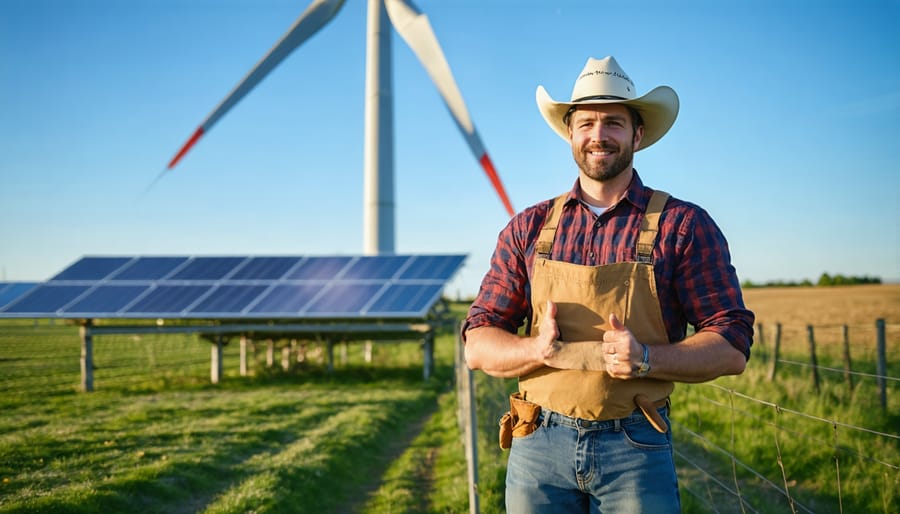
Southern Alberta Dairy Farm Case Study
The Henderson Family Dairy Farm in Lethbridge County has become a shining example of successful wind energy storage implementation in Southern Alberta. In 2019, the farm installed a 100kW wind turbine system coupled with a 250kWh battery storage solution, transforming their energy management approach.
“We used to struggle with high electricity costs, especially during milking times,” explains Sarah Henderson, third-generation dairy farmer. “Now, our stored wind energy handles peak demands, and we’ve cut our energy bills by 65%.”
The system captures excess wind energy during high-wind periods, typically occurring in the evening and overnight. This stored energy powers essential operations during calm periods and peak usage times, including the automated milking system, milk cooling, and barn ventilation.
The Hendersons worked closely with local renewable energy experts and utilized the Alberta Agricultural Solar Program to offset installation costs. The total investment of $275,000 had a payback period of just under six years, accelerated by rising utility rates and carbon pricing.
The farm’s success has inspired neighbouring agricultural operations, with five other dairy farms in Southern Alberta now implementing similar systems. Beyond cost savings, the Hendersons report improved energy reliability during winter storms, a critical benefit for their 200-head dairy operation.
“It’s about more than savings,” Sarah notes. “We’re building resilience into our operation while doing our part for the environment.”
Mixed Crop Farm Integration Story
Sarah McKenzie’s 400-hectare mixed crop farm in Lacombe County showcases how wind energy storage can seamlessly integrate with traditional farming operations. In 2019, McKenzie installed two 100kW wind turbines alongside her canola and wheat fields, coupling them with a 500kWh battery storage system.
“Initially, I was concerned about how the turbines might affect my crop spraying patterns,” McKenzie explains. “But we carefully positioned them along existing field boundaries, which actually created natural windbreaks for my crops.” The installation required minimal land, using just 0.3 hectares of previously unused corner space.
The storage system provides reliable power for her grain drying operations during harvest season, significantly reducing her reliance on grid electricity during peak demand periods. During winter months, the stored energy powers her workshop and storage facilities, with excess energy feeding back into the local grid.
McKenzie’s system paid for itself within four years through reduced energy costs and Alberta’s renewable energy credit program. She notes that the biggest advantage came during the 2021 harvest when a three-day power outage hit the region. “While other farms had to pause their drying operations, we continued working without interruption. That alone justified the entire investment.”
Her success has inspired five neighboring farms to explore similar integrations, creating a growing community of wind energy advocates in central Alberta.
Getting Started with Wind Energy Storage
Assessment and Planning
Before investing in wind energy storage, it’s crucial to conduct a thorough assessment of your farm’s specific needs and potential. Start by analyzing your current energy consumption patterns through a detailed energy audit, tracking usage throughout different seasons and times of day. This will help identify peak demand periods and establish baseline requirements for your storage system.
Consider working with a local renewable energy consultant to evaluate your property’s wind resources. They can conduct wind speed measurements at various heights and locations across your land, typically over 12 months, to determine the most effective placement for turbines and storage facilities.
Calculate your storage capacity requirements by factoring in:
– Daily energy consumption
– Seasonal variations in wind patterns
– Critical power needs during calm periods
– Future expansion plans
– Budget constraints
Many Alberta farmers find success with hybrid systems that combine wind storage with other renewable sources. For example, the Thompson family farm near Lethbridge implemented a wind-solar hybrid system with battery storage, reducing their annual energy costs by 60%.
Take advantage of available resources through local agricultural extension services and renewable energy associations. They often provide assessment tools and can connect you with experienced farmers who’ve already implemented similar systems. The Alberta Wind Energy Association offers free site assessment guidelines specifically developed for our region’s unique conditions.
Remember to review municipal regulations and grid connection requirements early in your planning process, as these factors can significantly impact your system design and implementation timeline.
Available Support and Resources
Alberta farmers interested in wind energy storage solutions have access to numerous support systems and funding opportunities. The Canadian Agricultural Partnership (CAP) offers grants of up to $250,000 for sustainable energy projects, including wind energy storage installations. The Alberta Agricultural Research and Innovation Trust (AARIT) provides matching funds for innovative agricultural technologies.
Technical assistance is readily available through the Alberta Clean Technology Agricultural Network (ACTAN), which connects farmers with certified energy consultants and engineers specializing in renewable energy systems. These experts offer site assessments, system design guidance, and implementation support at subsidized rates.
Local agricultural extension offices maintain a network of experienced professionals who can provide free initial consultations and direct you to relevant resources. The Southern Alberta Alternative Energy Partnership (SAAEP) hosts monthly workshops and networking events where farmers can connect with others who have successfully implemented wind energy storage systems.
For hands-on learning, the Alberta Farm Renewable Energy Demonstration Program offers site tours of operational wind energy storage systems throughout the province. These visits provide valuable insights into real-world applications and maintenance requirements.
Financial institutions like Farm Credit Canada and ATB Financial offer specialized loan programs for renewable energy projects, with competitive interest rates and flexible repayment terms designed specifically for agricultural operations.
As Alberta farmers, we’re uniquely positioned to lead the charge in sustainable agriculture through wind energy storage solutions. The combination of our province’s abundant wind resources and the growing need for reliable, clean energy makes this technology particularly valuable for our farming operations. By implementing these storage systems, we can significantly reduce our energy costs while contributing to environmental stewardship.
The success stories we’ve shared from local farms demonstrate that wind energy storage is not just a concept, but a practical reality that’s already working for our neighbours. Whether you’re considering a small-scale battery system or a larger hydrogen storage solution, there are options to suit every farm’s needs and budget.
Take the first step today by connecting with local agricultural extension services or joining community renewable energy initiatives. Together, we can build a more sustainable and prosperous future for Alberta’s farming community while setting an example for agricultural regions across Canada.

